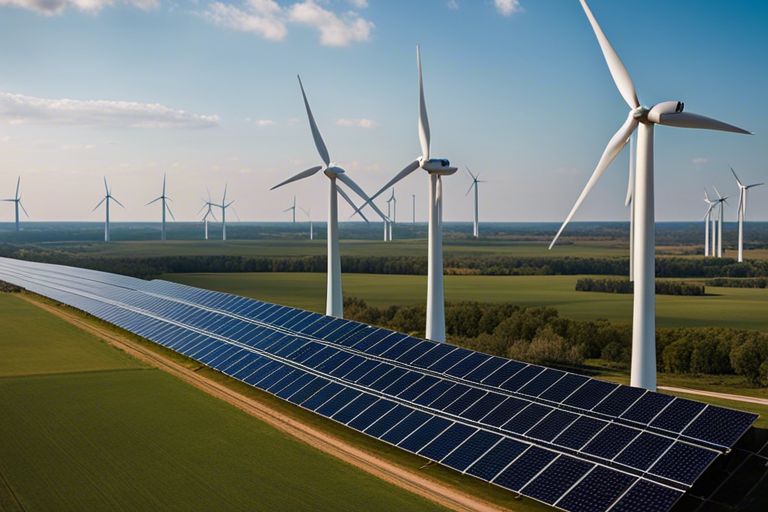You may be wondering if wind and solar energy have the potential to replace coal in Oklahoma’s electricity generation. As the third-largest coal consumer in the country, Oklahoma heavily relies on coal-fired power plants for its electricity needs. However, with the growing concerns over climate change and the declining costs of renewable energy technologies, the state is facing a crossroads in its energy future. In this post, we will explore the viability and challenges of transitioning from coal to wind and solar power in Oklahoma.
Key Takeaways:
- Oklahoma has the potential to replace coal with wind and solar: Given its vast wind resources and increasing solar capacity, Oklahoma has the opportunity to transition from coal to renewable energy sources.
- Cost-effectiveness: Wind and solar energy production costs are decreasing, making them competitive with coal in terms of affordability.
- Environmental benefits: Transitioning to wind and solar energy can significantly reduce greenhouse gas emissions and air pollution, improving public health and the environment.
- Job creation: The renewable energy sector can create new job opportunities for Oklahomans, supporting economic growth and diversification.
- Investing in infrastructure: Upgrading the grid and implementing energy storage solutions are vital steps to ensure a reliable and resilient transition to wind and solar energy in Oklahoma.
The Economics of Renewable Transition
Cost Comparisons Between Coal and Renewables
Renewable energy sources like wind and solar power are increasingly becoming cost-competitive with coal in Oklahoma. The table below illustrates the cost comparisons between coal and renewables:
| Energy Source | Cost per Kilowatt-hour |
| Coal | $0.05 |
| Wind | $0.03 |
| Solar | $0.04 |
Investment and Job Creation Prospects
Renewables present exciting investment and job creation prospects in Oklahoma. With the transition to wind and solar energy, there are opportunities for significant investment in infrastructure development and technology. Additionally, the renewable energy sector can lead to the creation of new jobs in manufacturing, installation, maintenance, and more.
Creation of renewable energy projects not only addresses environmental concerns but also stimulates economic growth. The shift to renewables in Oklahoma has the potential to attract investors looking for sustainable opportunities while creating a skilled workforce for the future.
Technical Feasibility
Energy Storage and Grid Management
It is crucial to address the issue of energy storage and grid management when considering the feasibility of replacing coal with wind and solar power in Oklahoma. Energy storage solutions such as batteries and pumped hydro storage are important to store excess energy generated during peak production periods for use during low production times. Grid management technologies play a pivotal role in balancing the intermittent nature of wind and solar power to ensure a reliable supply of electricity to consumers.
Challenges of Intermittency
For a successful transition to a renewable energy future in Oklahoma, the challenges of intermittency must be carefully navigated. Energy from wind and solar sources is not continuously available, leading to fluctuations in power supply that can strain the grid. To overcome these challenges, innovative grid integration techniques and advanced forecasting technologies are necessary to optimize the use of renewable resources and minimize reliance on fossil fuels.

Environmental and Health Considerations
Air Quality and Emission Reduction
Despite the reliance on coal for electricity generation in Oklahoma, transitioning to wind and solar energy can significantly improve air quality and reduce harmful emissions. Wind and solar power produce virtually no air pollutants during operation, unlike coal-fired power plants that release sulfur dioxide, nitrogen oxides, particulate matter, and other pollutants into the atmosphere. By replacing coal with renewable energy sources, Oklahoma can lower respiratory illnesses, heart diseases, and premature deaths caused by air pollution.
Long-term Climate Benefits
Considerations must be given to the long-term climate benefits of shifting from coal to wind and solar energy in Oklahoma. This transition can mitigate the effects of climate change by reducing greenhouse gas emissions, especially carbon dioxide, which is the primary driver of global warming. By embracing renewables, Oklahoma can contribute to global efforts to combat climate change and create a more sustainable future for generations to come.
This shift is crucial in addressing the looming climate crisis, as coal-fired power plants are among the largest emitters of greenhouse gases that trap heat in the atmosphere. Transitioning to wind and solar energy can significantly reduce carbon emissions, helping to curb global warming and its catastrophic impacts on weather patterns, sea levels, and ecosystems. The long-term climate benefits of renewable energy far outweigh the short-term challenges of transitioning from coal.
Policy and Regulatory Framework
State Incentives for Renewable Energy
All states play a crucial role in promoting renewable energy adoption, and Oklahoma is no exception. One of the ways this is achieved is through state incentives for renewable energy. In Oklahoma, these incentives include tax credits, property tax exemptions, and net metering policies that encourage individuals and businesses to invest in wind and solar technologies. These measures not only help to reduce the carbon footprint but also stimulate economic growth in the renewable energy sector.
Federal Support and Mandates
Concerning accelerating the transition from coal to renewable energy sources, federal support and mandates play a significant role. Any efforts made at the federal level to provide financial incentives, research and development funding, or renewable energy mandates can greatly impact Oklahoma’s energy landscape. This support can help drive innovation, encourage investments in clean energy, and ultimately reduce the reliance on coal for electricity generation.
Understanding the importance of federal support and mandates is crucial for the successful integration of wind and solar energy into Oklahoma’s electricity generation mix. Initiatives such as the Production Tax Credit, Investment Tax Credit, and Renewable Portfolio Standards are vital tools that can help accelerate the shift towards cleaner energy sources. By leveraging federal support and mandates, Oklahoma can not only reduce its carbon emissions but also ensure a more sustainable and resilient energy future for the state.

Community Impact and Acceptance
Public Perception of Renewables
Unlike traditional coal plants, wind and solar energy projects are often viewed favorably by the public due to their cleaner environmental footprint. In Oklahoma, a state known for its strong ties to the oil and gas industry, there has been a noticeable shift in public perception towards renewable energy sources. Communities are beginning to embrace wind and solar projects not only for their environmental benefits but also for the economic opportunities they bring.
Addressing Displaced Workers in the Coal Industry
Renewables offer a potential solution to address the concerns of workers in the coal industry facing displacement as the shift towards cleaner energy sources continues. Perception of job security in renewable energy sectors is growing as technologies advance and investments increase. Workers in the coal industry have the opportunity to transition their skills to jobs in the wind and solar sectors, where new employment opportunities are emerging.
To wrap up
Ultimately, while wind and solar energy have the potential to significantly reduce Oklahoma’s reliance on coal for electricity generation, completely replacing coal may not be feasible in the near future due to factors such as intermittent energy production and storage limitations. However, with advancements in technology, increased investment in renewable energy infrastructure, and support from policymakers, it is possible for wind and solar to play a larger role in Oklahoma’s energy mix. By embracing a diversified energy portfolio that includes renewable sources, Oklahoma can move towards a more sustainable and environmentally friendly future while also ensuring energy reliability and affordability for its residents.
FAQ
Q: Why is it important to consider replacing coal with wind and solar in Oklahoma’s electricity generation?
A: It is crucial to consider replacing coal with wind and solar in Oklahoma’s electricity generation to reduce carbon emissions, combat climate change, and transition to more sustainable and renewable energy sources.
Q: Are wind and solar energy reliable sources of electricity in Oklahoma?
A: Yes, wind and solar energy are increasingly reliable sources of electricity in Oklahoma due to technological advancements, improved efficiency, and better grid integration.
Q: How does the cost of wind and solar compare to coal in Oklahoma?
A: The cost of wind and solar energy has significantly decreased in recent years, making them competitive with or even cheaper than coal in Oklahoma. Additionally, wind and solar do not have fuel costs like coal, making them more economically attractive in the long run.
Q: What are the environmental benefits of replacing coal with wind and solar in Oklahoma?
A: Replacing coal with wind and solar in Oklahoma results in reduced air pollution, lower greenhouse gas emissions, and overall improved air quality, which leads to a healthier environment and community.
Q: Is Oklahoma’s infrastructure capable of supporting a transition to wind and solar energy?
A: Yes, Oklahoma’s infrastructure is well-suited for a transition to wind and solar energy, given its vast land area, strong wind resources, abundant sunshine, and existing energy infrastructure that can be adapted to accommodate renewable energy sources.
Q: What are the challenges associated with replacing coal with wind and solar in Oklahoma?
A: Challenges include intermittency of wind and solar energy, energy storage limitations, grid modernization needs, potential job displacement in the coal industry, and policy and regulatory hurdles that need to be addressed for a smooth transition.
Q: What steps can Oklahoma take to accelerate the adoption of wind and solar energy and phase out coal?
A: Oklahoma can incentivize renewable energy development through policies such as tax credits, renewable portfolio standards, net metering, and grid modernization initiatives. Collaboration between government, industry, and communities is imperative for a successful transition away from coal towards wind and solar energy.




